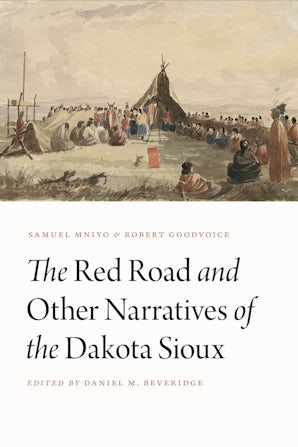List of Illustrations
Foreword by David R. Miller
Editor’s Preface and Acknowledgments
List of Abbreviations
Part 1. Editor’s Introduction
The Red Road (Ċaŋkú Dúta) and the Holy Dance (Wak̇áŋ Waċípi)
Four Strands, One Rope
Sam Buffalo/Samuel Mniyo
Dan Beveridge
Robert Goodvoice
Jim Sapa/James Black
The Dakóta Oyáte (Dakota Nation)
Early Migration Theories
The Wak̇áŋ Waċípi (Holy Dance) and Ċaŋkú Dúta (Red Road) in Comparative Perspective
The Wak̇áŋ Waċípi (Holy Dance)
The Ċaŋkú Dúta (Red Road)
The Origin of the Medicine Dance (Holy Dance) and the Red Path (1972)
The Wak̇áŋ Waċípi in Dakota Society
Origin Stories
Performance
Songs, Song Boards, and Song Sticks
Organization of the Book
Note on Editing and Orthography
Part 2. The Narratives of Samuel Mniyo (Sam Buffalo)
Introduction
Why and How This Story Was Written
Four Eras in Isáŋti Dakota History
Who Taught Me These Stories
The Era of the Red Road Journey (Tiwópida Oíhduhe)
The Red Road Journey of the Dakota People, 1977
The Wak̇áŋ Waċípi Ok̇odakíċiye (Holy Dance Society) and Ċaŋkú Dúta Owíċimani (Red Path Journey), 1965
The Song Stick (Wak̇áŋ Dowáŋpi), 1966 and 1967
The Wak̇áŋ Waċípi Ok̇odakíċiye (Holy Dance Society) and Ċaŋkú Dúta Owíċimani (Red Road Journey), 1977
The Wak̇áŋ Waċípi Ok̇odakiċiye (Holy Dance Society) and Ċaŋkú Dúta Owiċimani (Red Road Journey), 1985
The Wak̇áŋ Waċípi Ok̇odakiċiyepi (Holy Dance Society) and Ċaŋkú Dúta Owiċimani (Red Road Journey), 1997
The Legend of Corn, 1997 and 1999
The Dakota Turning Point: The Dakota Divided (Three Versions)
The Red Road Journey Continues, 1997
The Circle Power Era (Tiyóti Oíhduhe)
Changing from the Tiwópida Oíhduhe to the Tiyóti Oíhduhe (part 1)
Changing from the Tiwópida Oíhduhe to the Tiyóti Oíhduhe (part 2)
Tiyóti Oíhduhe: The Tiyóti System (The Circle System) in Dakota Society
The Seven Circles
The Sacred Hoop: Learning and Teaching over the Life Span
The Sacred Hoop: Comparing the Tiwópida Oíhduhe and the Tiyóti Oíhduhe
Learning and Teaching over the Life Span: Belief, Identity, Skills, Attitudes
Belief: The Story of Kas’ákuwiŋ
Identity
Skills: The Story of Tióde
Attitude
Friendship: The Story of Siŋkpé
Learning and Teaching under the Circle System (continued)
The Trading and Reserve Era or the Christian Era and Adjusting to Life on Reserves
Beginning Life on Reserves: Upper Sioux
The End of the Tiyóti System: The Christian Church as Wópida
The Minnesota Massacre
My Family History: How the Isáŋti People Came to Canada
Chief Whitecap
The Dakota Bands in Canada; the Little Red River Sioux Camp and the Last Tiyóti Oíhduhe
The Little Red River Sioux Camp I.R. 94B, the Establishment of Wahpeton Dakota Reserve 94A
The Present Challenge
Dakota Elders’ Predictions about Reserve Life; Living Well and Living Disorderly; the Early Promise of Reserve Life
Rule by Indian Agents, Breakdown of Traditional Practices, Kahómni Dance, Disorganization and Organization, We Live Disorderly, Odákota Is Confused
The Present Challenge
Samuel Mniyo’s Own Story
Three Events in My Early Life Experience
Visions and Dreams: Four Meetings with My Spiritual Guide
Sam’s Birth
Sam and Dan by Daniel M. Beveridge
Samuel Mniyo’s Time Line by Daniel M. Beveridge
Part 3. The Narratives of Robert Goodvoice
Traditional History
Introduction: Learning Traditional Knowledge and Skills from the Older Generations, and the Loss of Culture (part 1)
The Origin of the Ċaŋkú Dúta (Red Road or Red Path) and Wak̇áŋ Waċípi (Holy Dance or Medicine Dance), 1972 version
The Origin of the Ċaŋkú Dúta (Red Path) and the Gift of Medicinal Plants, 1977 version
Becoming a Member of the Ċaŋkú Dúta (Red Path) Society
Learning Traditional Knowledge, Skills and Medicine from the Older Generations (part 2)
How the Dakota People Began the Sundance
Uŋktómi, Dakota Spirit Helper
Living in the Four Circles, the Tiyótipi, Dividing into Sub-tribes, Moving Northeast
The Names of the Twelve Months
Relations with the White Men
First Contact with Europeans
The War of 1812: Alliance with the British; Promises and Rewards; Seven Boatloads (Oċéti Ṡakówiŋ); The Medals; Boundary Cairns
The Treaty of 1851
The 1862 Dakota War
Dispersal, and Ṫaċáŋ Iṡóta’s Search for His Parents
The Kidnapping and Pursuit of Dakota Leaders after 1862
The Move to Prince Albert
James McKay, Húpa Iyáḣpeya and the 1876–1877 Trek to the Prince Albert District
The Wahpeton Chiefs; Ahíyaŋke Obtains Land for Round Plain Reserve in 1893
How My Grandfather Was Lost and Received Guidance from a Poplar Tree
People with the Power to Find Things
Part 4. The Wak̇áŋ Waċípi Songs and Song Stick of Henry Two Bear and the Pictographic Notebooks of James Black (Jim Sapa)
Introduction
Daniel M. Beveridge
Discovering the Wak̇áŋ Waċípi Dakota Song Stick
Dan Beveridge
A Prairie Puzzle: The Wakan-Wacipi Dakota Song Stick
Henry Two Bear: Transcriber of the Songs and Keeper of the Song Stick
Comments by Samuel Mniyo
Comments by Dan Beveridge
The Henry Two Bear Song Stick or Song Board (Wak̇áŋ Dowáŋpi)
Dan Beveridge
The Songs of the Wak̇áŋ Waċípi
Introduction
Dan Beveridge and Jurgita Antoine
The Songs of the Wak̇áŋ Waċípi (Wak̇aŋ Waċipi Odowaŋ)
As written down by Henry Two Bear and retranscribed and translated by Jurgita Antoine
Songs Texts in Free Translation
The Songs: As transcribed by Henry Two Bear
James Black, Keeper of the Notebooks, and the Last Wak̇áŋ Waċípi Ceremony
Samuel Mniyo
The Pictographic Notebooks of James Black (Jim Sapa)
Dan Beveridge
Introduction
The Images
Appendix 1. Santee (Eastern Sioux) History Timeline
Appendix 2. Family History and Family Tree of Sam Buffalo
Appendix 3. Biographical Sketches
Appendix 4. Oral History of the Wahpaton Dakota
Appendix 5. Etude de cas: Une tradition chez les Dakotas
Appendix 6. Guide to Pronunciation and Orthography
Glossary
Notes
Bibliography
